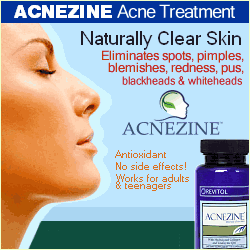Flaxseed Oil and Acne
Flaxseed Oil and Acne
Whilst there have not been many flaxseed oil and acne studies carried out, flaxseed supplements remains a popular acne treatment, with both natural therapists and acne sufferers.
Flaxseed is traditionally used as a natural laxative, providing bulk to the stool as well as lubrication. But flax oil has many other benefits, which derive from its richness in the omega 3 essential fatty acid. Essential fatty acids are so named because we must get them from our diet - our bodies do not make them. They are important for normal growth and development, brain function, and help prevent chronic illnesses like arthritis and heart disease.
Essential fatty acids come in several forms, the most commonly known being the omega 3 fatty acids and the omega 6 fatty acids. Omega 6 fatty acids are more common in our Western diets, being found in oils like safflower, sunflower, corn, sesame, and other oils. It is possible to have a deficiency of omega 6 fatty acids if relying only on omega 3 fats, like flax and fish oils, as the main type of fat in the diet. Or if taking the omega 3 fatty acids in greater quantities for a period of one and a half, to two years, to restore an omega 3 deficiency. But the more likely scenario is that an excess of omega 6 fatty acids is being consumed in relation to the omega 3's.
Symptoms of omega 3 fatty acid deficiency include dry skin, sticky platelets, and tissue inflammation. Given that inflammation is of particular concern for acne sufferers, it becomes easier to see why increasing the amount of omega 3 fatty acids in the diet remains a popular natural acne treatment.
Omega 3 fatty acids can be found in certain types of fish like salmon and mackerel, and flaxseed oil. And as well as reducing inflammation, omega 3's speed up healing - again, important for acne sufferers - and reduce platelet stickiness. Platelet stickiness becomes important beyond heart health when you consider that the blood cells carry the supply of oxygen to cells, including cells in our skin, and the cells that are involved in healing.
There are 3 types of omega 3 fatty acids that are significant. These are alpha linolenic acid (ALA or LNA), eicosapentaenoic acid (EPA), and docosahexanoic acid (DHA). ALA (or LNA, as it is often abbreviated to) is converted into EPA and DHA by the body. EPA and DHA are the forms in which the omega 3's are most easily used by the body. Supplementation with ALA has been found to reduce inflammation and improve dry skin.
Flaxseed oil is a very good source of ALA, containing an average of 55% and higher. But to carry out the conversions into EPA and DHA, the body needs to have good levels of zinc, magnesium, vitamin C, vitamin B3 and vitamin B6.
The recommended intake of ALA is about 2,220 mg per day. Higher doses are recommended to treat deficiencies, or some conditions. There is no real standard recommendation for acne sufferers simply because not enough studies have been done in relation to acne. But doses of 3000 to 6000 mg per day are used to prevent and treat some chronic conditions.
Click here for detail












0 comments:
Post a Comment